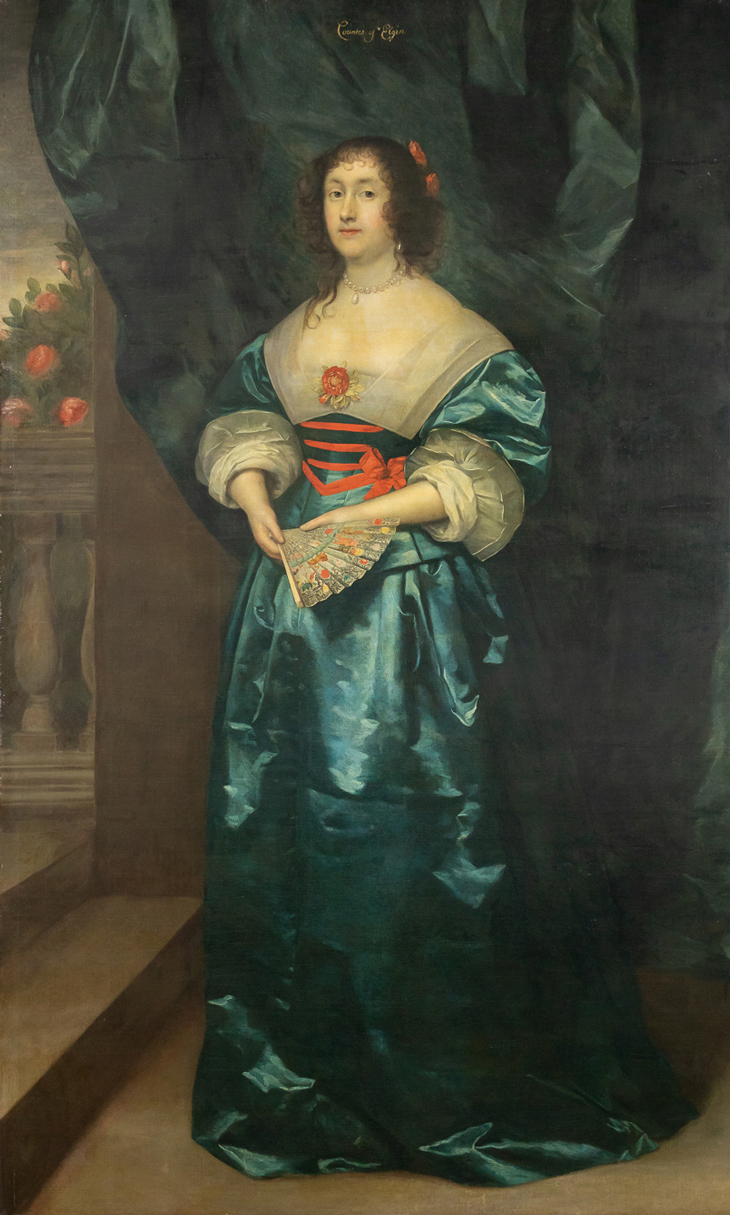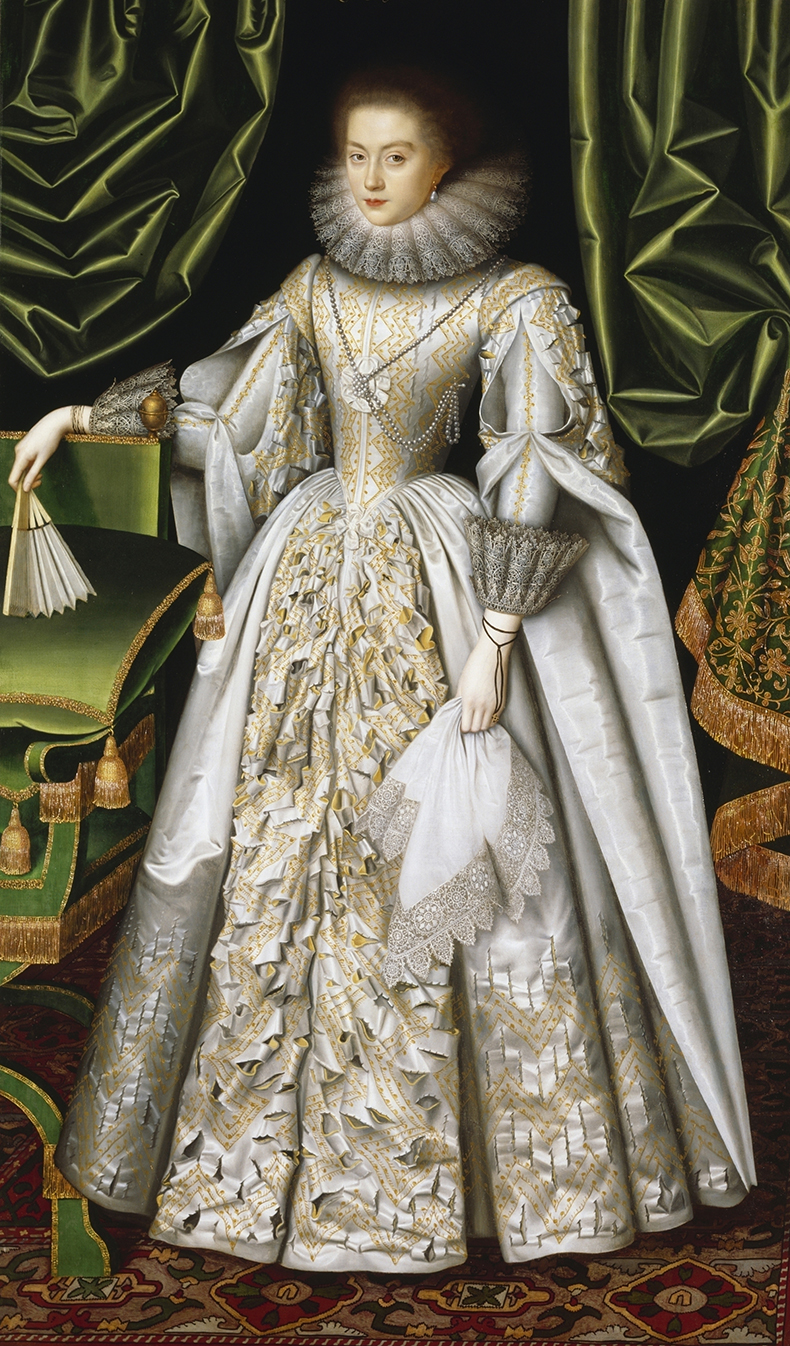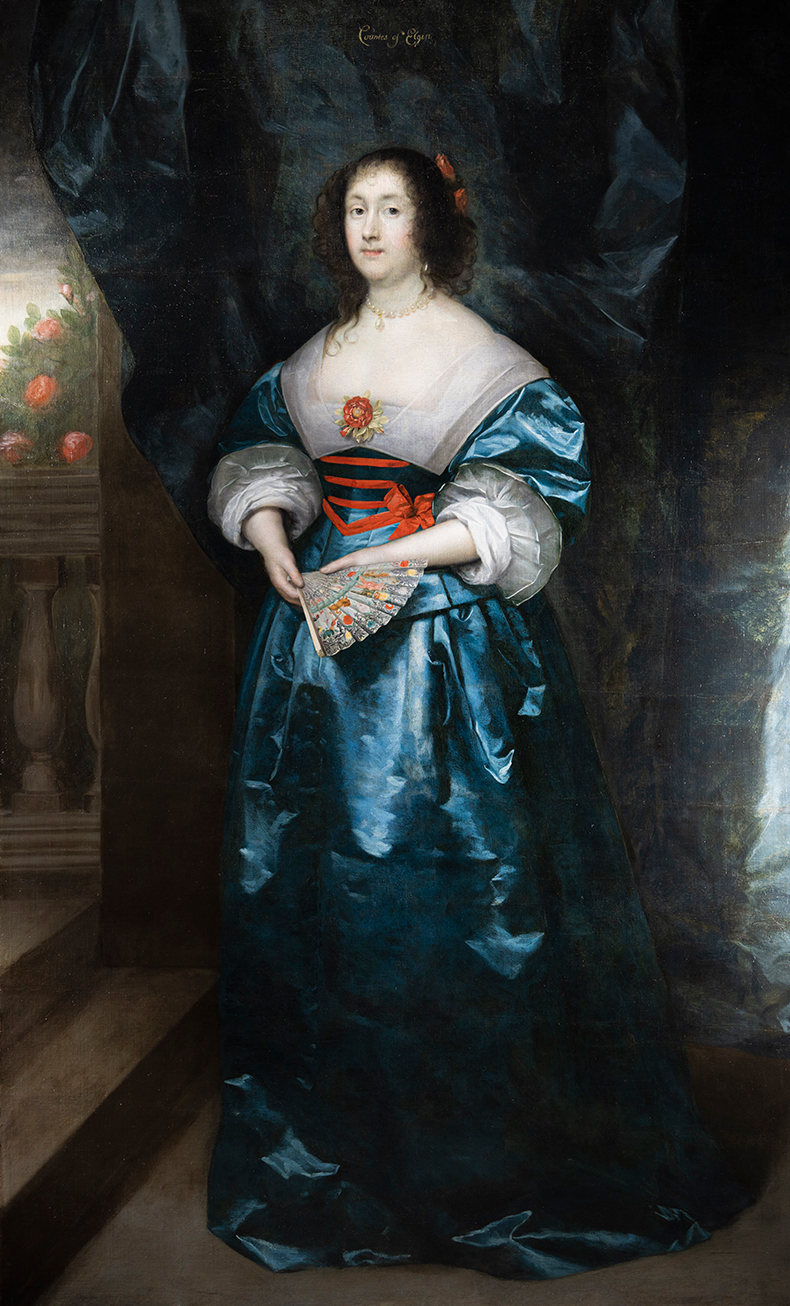In November, conservators working on Cornelius Johnson’s 1634 portrait of Lady Diana Cecil revealed that they had peeled back layers of later overpainting, most likely from the 19th century, in order to restore her ‘natural beauty’. This piqued the national interest. The Guardian, The Times and Tatler all quoted Louise Cooling, English Heritage curator at Kenwood House where the painting is now on display, saying that digital beauty filters and AI enhancers were nothing new: the Stuart noblewoman’s beauty had been amplified by later generations, who had gifted her slightly fuller lips and more hair. The temptation to run an accompanying photo of cosmetics entrepreneur Kylie Jenner proved irresistible.

The portrait before conservation, showing evidence of later retouching
All good fun, but perhaps a little broad brush. The later overpainting can hardly have been done to flatter the former countess of Elgin, who died in 1654. It was more likely to have been carried out to make it more typically of its period. The changes bring it more in line with Victorian ideas about the beauty standards of the court of Charles I. That fringe was added not to reduce the size of Diana Cecil’s forehead, but to mark her out as one of Queen Henrietta Maria’s acolytes. In 1634 wispy curls teased to frame the face were de rigueur at court, as were large pearl earrings and necklace. There was a high degree of conformity among ladies’ dress in court, almost as if they were proving their loyalty to the conspicuously French queen (whose Catholicism had prevented her from being crowned alongside her husband), although to see recusancy encoded in a fringe is probably going too far.
Lady Diana Cecil was one of the Queen’s inner circle, along with Venetia Stanley (who inspired me to write Viper Wine, a novel about beauty standards of the time). They both appeared in the elaborate court masques, often in the Whitehall Banqueting House, with advanced lighting effects and costumes by Inigo Jones. Diana Cecil played one of the seven stars in Aurelian Townshend’s masque of 1632, Tempe Restored. No doubt she shone, decorously. There were actresses present to do the actual singing and dancing.

Diana Cecil (c. 1614–18), William Larkin. Kenwood, London. Courtesy English Heritage
She was painted by William Larkin in about 1613 as an already rather stately young teen. He also made an almost identical portrait of her twin sister, Anne: apart from the girls’ hair colour, an apple cleft in two is not more twin than these two paintings (to adapt the line about Viola and Cesario from Twelfth Night). Culture moved on and that interest in twins and optical illusions, and that stiff, slashed gown looked old news, practically Tudor, by the time she sat for Johnson in 1634; as a woman of fashion she would by then have wanted something more sensuous, more naturalistic, more Van Dyck. Perhaps the later retoucher also hoped a little more lippy would give the portrait an air of Van Dyck; Cornelius Johnson was prolific but plodding by comparison.
Diana Cecil wed first Henry De Vere, the earl of Oxford, who died abroad a year later, then Thomas Bruce, the 2nd Lord of Kinloss and 1st Earl of Elgin. When she predeceased him in 1654, he commissioned her marble funeral bust, as was then conventional, and set it in a brick mausoleum. The funeral bust of the deceased noblewoman was a convention; Venetia Stanley’s was consumed in the Great Fire of London, but Diana Cecil’s, restored, can be seen in the mausoleum in the Bedfordshire village of Maulden.
Ideals of beauty in the 17th century were inextricably bound up with nobility and virtue. When one reads Ben Jonson’s panegyrics to his patrons, he seems dazzled by their importance and advantage; their high birth and graciousness make them beautiful to him. Diana Cecil, twice a countess and a granddaughter of Elizabeth I’s trusted chancellor, was foremost a great lady, her looks beside the point.
She was not flattered by Van Dyck, when he finally came to paint her in 1638, when the Stuart court was looking into the abyss of civil war. He gave her, along with some avoirdupois, plenty of curls and a rubious cupid’s bow. Perhaps we should call it a ‘Van Dyck filter’ and have done with it.

Diana Bruce née Cecil, 1st Countess of Elgin (1634), Cornelius Johnson. Kenwood, London. Courtesy English Heritage
Cornelius Johnson’s painting of Diana Cecil is now on display at Kenwood House, London.

Cosmetic surgery – a Stuart beauty is restored to her natural state
Diana Bruce née Cecil, 1st Countess of Elgin (detail; 1634), Cornelius Johnson. Kenwood, London. Courtesy English Heritage
Share
In November, conservators working on Cornelius Johnson’s 1634 portrait of Lady Diana Cecil revealed that they had peeled back layers of later overpainting, most likely from the 19th century, in order to restore her ‘natural beauty’. This piqued the national interest. The Guardian, The Times and Tatler all quoted Louise Cooling, English Heritage curator at Kenwood House where the painting is now on display, saying that digital beauty filters and AI enhancers were nothing new: the Stuart noblewoman’s beauty had been amplified by later generations, who had gifted her slightly fuller lips and more hair. The temptation to run an accompanying photo of cosmetics entrepreneur Kylie Jenner proved irresistible.
The portrait before conservation, showing evidence of later retouching
All good fun, but perhaps a little broad brush. The later overpainting can hardly have been done to flatter the former countess of Elgin, who died in 1654. It was more likely to have been carried out to make it more typically of its period. The changes bring it more in line with Victorian ideas about the beauty standards of the court of Charles I. That fringe was added not to reduce the size of Diana Cecil’s forehead, but to mark her out as one of Queen Henrietta Maria’s acolytes. In 1634 wispy curls teased to frame the face were de rigueur at court, as were large pearl earrings and necklace. There was a high degree of conformity among ladies’ dress in court, almost as if they were proving their loyalty to the conspicuously French queen (whose Catholicism had prevented her from being crowned alongside her husband), although to see recusancy encoded in a fringe is probably going too far.
Lady Diana Cecil was one of the Queen’s inner circle, along with Venetia Stanley (who inspired me to write Viper Wine, a novel about beauty standards of the time). They both appeared in the elaborate court masques, often in the Whitehall Banqueting House, with advanced lighting effects and costumes by Inigo Jones. Diana Cecil played one of the seven stars in Aurelian Townshend’s masque of 1632, Tempe Restored. No doubt she shone, decorously. There were actresses present to do the actual singing and dancing.
Diana Cecil (c. 1614–18), William Larkin. Kenwood, London. Courtesy English Heritage
She was painted by William Larkin in about 1613 as an already rather stately young teen. He also made an almost identical portrait of her twin sister, Anne: apart from the girls’ hair colour, an apple cleft in two is not more twin than these two paintings (to adapt the line about Viola and Cesario from Twelfth Night). Culture moved on and that interest in twins and optical illusions, and that stiff, slashed gown looked old news, practically Tudor, by the time she sat for Johnson in 1634; as a woman of fashion she would by then have wanted something more sensuous, more naturalistic, more Van Dyck. Perhaps the later retoucher also hoped a little more lippy would give the portrait an air of Van Dyck; Cornelius Johnson was prolific but plodding by comparison.
Diana Cecil wed first Henry De Vere, the earl of Oxford, who died abroad a year later, then Thomas Bruce, the 2nd Lord of Kinloss and 1st Earl of Elgin. When she predeceased him in 1654, he commissioned her marble funeral bust, as was then conventional, and set it in a brick mausoleum. The funeral bust of the deceased noblewoman was a convention; Venetia Stanley’s was consumed in the Great Fire of London, but Diana Cecil’s, restored, can be seen in the mausoleum in the Bedfordshire village of Maulden.
Ideals of beauty in the 17th century were inextricably bound up with nobility and virtue. When one reads Ben Jonson’s panegyrics to his patrons, he seems dazzled by their importance and advantage; their high birth and graciousness make them beautiful to him. Diana Cecil, twice a countess and a granddaughter of Elizabeth I’s trusted chancellor, was foremost a great lady, her looks beside the point.
She was not flattered by Van Dyck, when he finally came to paint her in 1638, when the Stuart court was looking into the abyss of civil war. He gave her, along with some avoirdupois, plenty of curls and a rubious cupid’s bow. Perhaps we should call it a ‘Van Dyck filter’ and have done with it.
Diana Bruce née Cecil, 1st Countess of Elgin (1634), Cornelius Johnson. Kenwood, London. Courtesy English Heritage
Cornelius Johnson’s painting of Diana Cecil is now on display at Kenwood House, London.
Share
Recommended for you
The Elizabethan whodunit that has kept art historians guessing
Has Compton Verney uncovered the identity of the mysterious Master of the Countess of Warwick?
Mischief-making mistresses at the court of Charles II
How the women at the heart of the Restoration court ‘weaponised’ portraits that flaunted their influence over the king
London calling – Orazio Gentileschi’s The Finding of Moses at the court of Charles I
The National Gallery is raising funds to purchase Orazio Gentileschi’s biblical scene – once a prized possession of Queen Henrietta Maria